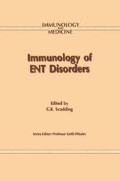Abstract
Survival of the individual depends on protection from pathogenic organisms, including protozoa, bacteria, viruses and fungi. This protection of the integrity of the individual is the major function of the immune system. Failure of components within the system results in a wide variety of immunodeficiency-associated diseases, frequently recurrent infections. The problems associated with immunodeficiency are explored further in the following chapter.
Access this chapter
Tax calculation will be finalised at checkout
Purchases are for personal use only
Preview
Unable to display preview. Download preview PDF.
References
Lucas AM, Douglas LC. Principles underlying ciliary activity is the respiratory tract. Arch Otolaryngol. 1934;20:518–41
Jeffery PK, Reid L. Electron microscopy of rat airway.1 Anat. 1975;120:295–320
Petruson B, Hanson HA, Karlsson G. Structural and functional aspects of cells in the nasal mucociliary system. Arch Otolaryngol. 1984;110:576–81
Rutland J, Cole PJ. Non-invasive sampling of nasal cilia for measurement of beat frequency and study of architecture. Lancet. 1980;2:564–5
Greenstone M, Logan-Sinclair R, Cole PJ. An automated method of recording nasal ciliary beat frequency. IRCS Med Sci. 1984;12:715–6
Holmstrom M, Lund VJ, Scadding GK. Nasal ciliary beat frequency following nasal allergen challenge. Am J Rhinol. 1992;6:101–5
Holmberg K, Pipkorn U. Mucociliary transport in the human nose. Effect of topical glucocorticoid treatment. Rhinology. 1985;23:181–5
Eid NS, Kravath RE, Lanks KW. Heat shock protein synthesis by human polymorphonuclear cells. J Exp Med. 1987;165:1148–52
Worthen GS. Lipid mediators, neutrophils and endothelial injury. Am Rev Resp Dis. 1987;136:455–8
Smedly LA, Tonnesen MG, Sandhaus RA, et al. Neutrophil-mediated injury to endothelial cells. Enhancement by endotoxin and essential role of neutrophil elastase. J Clin Invest. 1986;77:1233–43
Nourshargh S, Rampart M, Hellewell PG, et al. Accumulation of 111In-neutrophils in rabbit skin in allergic and non-allergic inflammatory reactions in vitro with a monoclonal antibody recognising the CD18 antigen. J Immunol. 1989;142:3193–8
Scadding GK, Lund VJ, Navas-Romero J, Darby YC, Seymour N, Turner MW. IgG3 subclass deficiency in chronic rhinosinusitis. Rhinology. 1994; 32: 15–19
Tonegawa S. Somatic generation of antibody diversity. Nature. 1983;302:575
Yancopoulos GD, Alt FW. Regulation of the assembly and expression of variable region genes. Annu Rev Immunol. 1986;4:339
Alt FW, Blackwell TK, Depinho RA, et al. Regulation of genome rearrangement events during lymphocyte differentiation. Immunol Rev. 1987;89:5
AllisonJPLanier LL. The structure, function and serology of the T-cell antigen receptor complex. Annu Rev Immunol. 1987;5:503
Ashwell JD, Klausner RD. Genetic and mutational analysis of the T cell antigen receptor. Annu Rev Immunol. 1990;8:139
Matis L. The molecular basis of T cell specificity. Annu Rev Immunol. 1990;8:65
Clevers H, AlarconBWileman T, et al. The T cell receptor/CD3 complex: a dynamic protein ensemble. Annu Rev Immunol. 1988;6:629
Ahmed A, Smith AH. Surface markers, antigens and receptors on murine T and B cells. CRC Crit Rev Immunol. 1983;4:19
Muller-Eberhard HJ. The membrane attack complex of complement. Annu Rev Immunol. 1986;4:503
Porter RR, Reid KBM. Activation of the complement system by antigen-antibody complexes: the classical pathway. Adv Protein Chem. 1979;33:1
Fearon DT. Activation of the alternative complement pathway. CRC Crit Rev Immunol. 1979;1:1
Editor information
Editors and Affiliations
Rights and permissions
Copyright information
© 1994 Springer Science+Business Media Dordrecht
About this chapter
Cite this chapter
Fitzharris, P. (1994). Basic Immunology. In: Scadding, G.K. (eds) Immunology of ENT Disorders. Immunology and Medicine Series, vol 23. Springer, Dordrecht. https://doi.org/10.1007/978-94-011-1436-3_1
Download citation
DOI: https://doi.org/10.1007/978-94-011-1436-3_1
Publisher Name: Springer, Dordrecht
Print ISBN: 978-94-010-4629-9
Online ISBN: 978-94-011-1436-3
eBook Packages: Springer Book Archive

